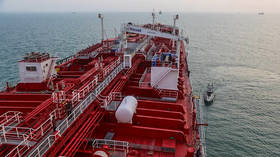Iran has perfected the art of hiding its oil tankers

Despite sanctions and mounting geopolitical pressure, Iran has managed to continue its crude deliveries thanks to the country’s skill in hiding its oil tankers.
Iran’s monthly oil exports deserve to be added to bookmakers’ lists. The sanction-bound country has ways to ship its crude oil largely undetected, with many cargo tracking firms struggling to come up with reliable data and media too quick to report numbers that become obsolete by the time the story is published.
“Iran is simply doing a better job of putting their oil into other people’s hands - or their own storage tin-cans - than anybody has expected,” says Genscape’s global director of petroleum intelligence, Devin Geoghegan, as quoted by Bloomberg.
Also on rt.com Tehran says Iranian tanker reached its destination, sold its oilIran is indeed doing a better job than anybody has expected: according to TankerTrackers.com, the country exported more than 800,000 bpd of crude oil and condensates, a number significantly higher than any other cargo tracking provider. Of this, more than 400,000 bpd had an unknown destination. According to Samir Madani, TankerTrackers.com co-founder, these barrels ended up on another vessel via ship-to-ship transfer, most likely involving Chinese vessels as receivers of the cargo.
According to cargo tracking industry insiders, the problem is that Iranian tankers go dark once they leave their port of departure, precisely to avoid being tracked on their way to the port of destination. OilX chief executive Florian Thaler told Oilprice that tracking a tanker’s location when the transponder is switched off requires a very advanced toolkit.
Not all tracking service providers have such a toolkit and to make matters even more complex, different trackers use different methods of tracking the cargoes. What’s more, ship-to-ship transfers seem to have become Iran’s go-to method of sanction avoidance, making it even more difficult to trace any given cargo from Iran to its destination.
Also on rt.com US oil market suffering as the trade war escalatesCould production numbers help gauge the state of Iran’s oil industry and, by direct association, exports? It seems so, according to Genscape. Based on data about gas flaring at Iran’s oil fields, the data analytics firm has calculated that since the first quarter of 2018, Iran’s oil production has only declined by about 15 percent.
But Genscape’s analysts go further: according to them, with production of some 3.9 million bpd, exports may be as high as 500,000 bpd and even 1 million bpd. However, Genscape’s Geoghegan told Bloomberg that a lot of the production was likely going into storage. Once this filled up, production could start declining further.
A sample of export figures for August paints a picture of uncertainty. TankerTrackers.com’s preliminary numbers show 671,000 bpd in crude oil exports, with condensate exports at zero. Energy shipping data provider Kpler’s latest figure is 160,000 bpd. OilX, the oil data analytics firm, has 361,000 bpd for August.
Also on rt.com ‘Piracy, bribery & blackmail’: Iran slams US sanctions as economic terrorism against civiliansAccording to TankerTrackers.com’s Madani, most data trackers have lower figures than the real ones because they only rely on data from the AIS transponder that every vessel has--the same transponders that Iranian tankers switch off during their trips to avoid detection. The addition of satellite imagery to the tracking equation, on the other hand, can provide a much more accurate picture. Yet even with satellite imagery, data differs between providers.
“There’s a wide array of diverging estimates of their exports in the industry, with a series of accounting problems causing erroneous higher numbers to come into some of these,” PetroLogistics’s chief executive Daniel Gerber told Bloomberg. According to him, the higher numbers include oil for storage rather than sales, while other inaccurate estimates are inaccurate because of accounting issues.
Madani told Oilprice that some trackers record all tanker loadings as exports even though not all of them end up sold abroad, instead destined for stores, either offshore or onshore.
It seems there will never be agreement on exactly how much oil Iran is shipping abroad. Yet one thing is certain: it is far from zero and unlikely to fall to zero anytime soon.
This article was originally published on Oilprice.com














